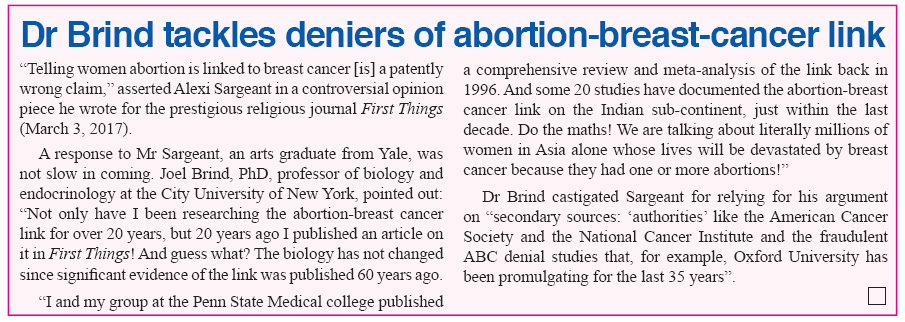Four million Indian women die from abortion-induced breast cancer
by Brett Rooney, MSc
South Asian women with induced abortion history nearly quadruple their odds of contracting breast cancer, according to the 2018 "study of studies", by Joel Brind PhD and others, of the ABC (abortion-breast-cancer) risk for the region.The study, "Induced abortion as an independent risk factor for breast cancer: A systematic review and meta-analysis of studies on South Asian women", by Joel Brind, Steven J. Condly, Angela Lanfranchi and myself (Brent Rooney), appeared in Issues in Law and Medicine, Vol. 33, No. 1, March-May 2018.
The meta-analysis provides the highest confidence pro or con about a claimed adverse health risk. It used data from 20 previously published breast cancer studies where the subjects were women in South Asia (that is, India, Bangladesh, Pakistan, Sri Lanka, Bhutan and Nepal).
In medical studies "abortion" can sometimes refer either to spontaneous abortion (miscarriage) or to induced abortion. Five of the 20 studies provided breast cancer data for South Asian women with prior induced abortions.
Any study that includes both miscarriage and induced abortion in the definition of "abortion" will underestimate the increased breast cancer risk inflicted by induced abortion history. When 15 studies where "abortion" includes both miscarriages and induced abortions are added to the five studies where "abortion" is restricted to induced abortions, the odds drop to 2.51 (+150% odds boost), which, of course, is an underestimate of the breast cancer risk of induced abortion history.
In 2016 the Indian population was 1.324 billion. Since there is a net addition of 1.1 million Indians per month (1.5 million births and 0.4 million deaths per month), the expected Indian population total will be 1.3504 billion by the end of 2018.
Since 48% of Indians are female, that means 648.2 million female Indians were alive during 2018. I estimate that, of all Indian women alive in 2018, approximately 4.06 million will die from induced abortion history. My estimate is based upon the following:
* 648.2 million Indian women were alive in 2018;
* induced abortion history multiplies breast cancer odds by 3.91 for Indian women;
* about 21.5% of Indian women have induced abortion history (a likely underestimate); and
* 50% of Indian women diagnosed with breast cancer die from it.
For most of the 20th century India had a very low breast cancer rate. By Western standards, India in the 21st century still has a low breast cancer rate.
There is a "however" here. American women, on average, diagnosed with breast cancer have "only" a 20% chance of dying from breast cancer, whereas an Indian woman diagnosed with breast cancer has a 50% risk of dying from breast cancer - that is two-and-a-half times the death risk of American women.
So, for Indian women, breast cancer has the same high death risk that ovarian cancer has in the United States.
I have never seen a copy of an Indian induced-abortion consent form. If abortion doctors in India follow the practice of abortion doctors in Western countries, very few Indian abortion consent forms will have the word "cancer" anywhere in them. If this is indeed also the case in India, then the abortion-breastcancer risk is an unconsented risk.
Is there any hope of reducing the future breast cancer rate in India?
It is clear to this writer that induced abortion history is the number-one breast cancer risk in India, whereas in Western countries there is competition for the number-one breast cancer risk spot. Contenders include oral contraceptives, induced abortion, and waiting until well after age 25 years to have a first delivery of a baby (full-term).
Markedly reducing the prevalence of induced abortion in India will reduce India's breast cancer rate for women born after 2018. It is better late than never to sharply reduce India's induced abortion rate.
Brent Rooney, MSc, is research director of the Vancouver-based
Reduce Preterm Risk Coalition and publishes the
Justice for Kids NOW bulletin, where this article originally
appeared, with notes and references, on October 10, 2018
![]()

